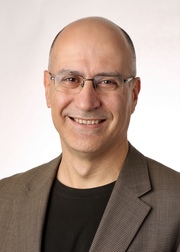
Prof Pablo Fernández-Penas
An expert group has developed a simple classification system for difficult to treat basal cell carcinomas (DTT-BCCs) to help guide treatment decisions and better predict outcomes for patients.
The classifications, based on five distinct patterns, are the first to categorise the rare but complex disease types, which are currently grouped under the catch-all ‘locally advanced BCC’ (LA-BCC).
It’s a term that specialists involved in managing the condition say is unhelpful, particularly because it attempts to cover highly heterogenous clinical situations – from common BCCs in a location where surgery will create some mutilation, to highly destructive BCCs deemed inoperable.
Investigators on the consensus panel say the absence of clear staging and outcome guidance means multidisciplinary treatment teams – including dermatology, oncology, surgery and radiotherapy specialists – are left struggling to reconcile different treatment approaches.
In a bid to close that gap, 14 international experts from different specialties, including some from Australia, independently categorised 199 DTT-BCCs into clusters based on their own criteria.
Modelling of those findings showed that consensus between experts was best represented by categorising DTT-BCCs into five clusters, which investigators say show clear-cut patterns of clinical situations.
Severity range
Ranging from least to most severe, Cluster 1 cases were described as common BCC but with more complex management either relating to the tumour – a location requiring technical skill or poorly defined tumour borders for instance – or to the comorbidity or general health status of the patient.
Despite the technical difficulties and as long as patients are cooperative, experts agreed that patients in this cluster could expect good results.
Cluster 2 is defined by very high numbers of common BCC (>10) or multiple complex BCC (>5) in apparently sporadic cases, or in Gorlin syndrome. Experts defined management as difficult mainly due to the multiplicity of BCC.
Meanwhile large or destructive tumours in non-critical areas or functionally significant areas fall into Cluster 3. Expert consensus suggests these cases are curable without expected functional mutilations.
Cluster 4 cases are those with large or destructive tumours in critical or functionally significant areas. These are deemed curable by surgery but functional impairment or mutilation will be inevitable, the group agreed.
Finally Cluster 5 tumours are categorised by giant or deeply invasive tumours involving bone, muscle, or sensorial structures. Experts agree that in these cases cure cannot be expected by surgery.
Australian input
Speaking to the limbic, Professor Pablo Fernández-Penas, co-author on the position statement, said the consensus findings suggest that despite the different approaches of different specialties, “experts are unconsciously able to translate and simplify the high heterogeneity of DTT-BCCs into a few dominant patterns to make their therapeutic decisions”.
The study however did pick up significant variability in what experts defined as ‘locally advanced’ BCC among DTT-BCCs, with many cases considered as really difficult to treat (score ≥3) not considered ‘LA-BCC’ by 50% of the experts.
“The five clusters may be a more consistent way to classify BCC between clinicians than the wording ‘locally advanced’ or ‘non advanced’,” said Prof Fernández-Penas, Head of Dermatology at Westmead Hospital, Sydney.
He adds that while the clusters will help clinicians define disease severity and discuss treatment options with patients and multidisciplinary teams – the consensus will also help to define outcomes for developing therapies for BCC.
The study is published in the Journal of the European Academy of Dermatology and Venereology